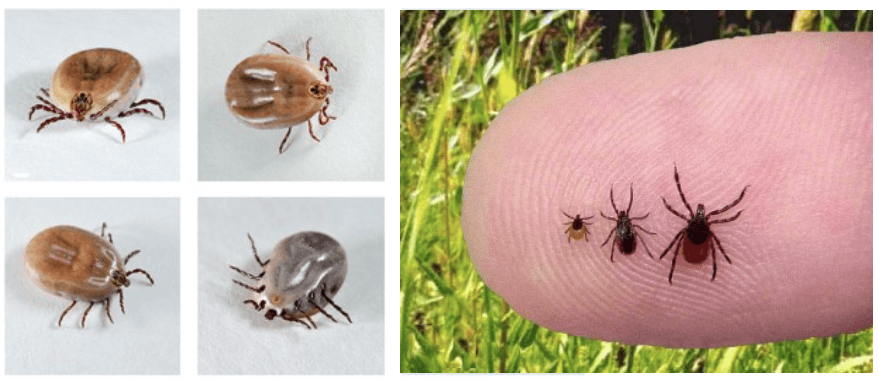Fleas and ticks love humid and warm environment like Hong Kong. Every time going outdoor bears a chance of getting these uninvited guests on your dog back home. A decease called tick fever maybe rings a bell, but do you know what it really is, how to detect the symptoms at early stage and minimise the risk?

What is tick fever in the simplest terms?
A disease that is spread by ticks who look fairly like beetles with eight legs. Commonly found in grassy environment, ticks attach themselves to animal skin and feast on the host’s blood.
Ticks are generally confined to specific geographical areas, but are introduced to other areas by wildlife, companion animals and humans. Ticks in Hong Kong have been shown to carry causative bacteria including Ehrlichia, Anaplasma, Babesia, and Borrelia. They destroy red blood cells and if left untreated, your dog might result in life-threatening anaemia which requires blood transfusion and hospitalisation. But if detected early, treatment can be carried out at home.
Related reading: What if your dog needs blood transfusion?
How does tick fever get transmitted to our dogs?
The ticks infected with this organism can stay in the competent reservoir hosts and transmit to both the hosts and other uninfected ticks.
Ticks acquire the infections by feeding on hosts and transmit the disease during subsequent feeding. The organisms take 1- to 3-week to multiply and disseminate throughout the body, where they may subsequently be associated with a multitude of clinical signs related to which tissues are affected. Clinical develops in 3 phases: acute, subclinical, and chronic.
The clinical signs for the tick-borne illnesses are similar. In the acute phase, dogs are often anorectic. Lymphadenomegaly and fever, evidence of anemia and petechia may be present. Thrombocytopenia, mild anemia, and leukopenia are often present from the blood test.
The acute phase usually lasts for 2–4 weeks. In untreated dogs, the dogs enter the subclinical phase after which clinical signs resolve, which may last for months to years. In this phase, dogs are still infected but are clinically normal, although mild thrombocytopenia usually persists. Immunocompetent dogs may clear the infection in this phase; otherwise, dogs may remain lifelong carriers or may enter the chronic phase, which can be associated or concurrent with severe disease later.
How to minimise the risk of getting ticks?
Routine use of tick-control products to treat individual animals and premises are necessary. If attached ticks are found on the animal, prompt removal may minimize transmission of tick-borne pathogens. Ticks should be removed carefully to ensure removal of the head and mouthparts and to avoid crushing to prevent exposure to hemolymph.
Many tick-control products available in veterinary hospitals. However, most common used products do not have insect repellents and found evidence of slowly developing of resistance. Therefore, they do not provide full protection. There are some new products available, or soon to be released into the market. They have more advantages by improving the speed of kill, effectiveness and safety. For example: Simparica (Zoetis) and Power Ultra (Brouwer).
What to look out for?
In acute tick-borne diseases, clinical signs are usually nonspecific signs of inflammation (fever, anorexia, lethargy, lymphadenomegaly). Some dogs may develop petechiation/ecchymosis, neurological abnormalities, muscle pain, peripheral edema, or dyspnea. In severe cases, dogs may develop weight loss and debilitation, bleeding, neurological abnormalities, polyarthritis, polyuria/polydipsia due to renal insufficiency, and secondary infections of bone marrow suppression. Fever is common in both the acute and chronic phases.
How to diagnose?
Thrombocytopenia and mild anemia are the most consistent blood abnormalities in animals with tick borne diseases. Thrombocytopenia often precedes the onset of clinical illness and persists through the subclinical phase of the disease. The white blood cell (WBC) count is variable and may show leukopenia or leukocytosis. Lymphocytosis may be seen. Some patients have pancytopenia. Elevated liver enzymes (alanine aminotransferase [ALT], alkaline phosphatase [ALP]) are also often seen. Kidney enzymes ( urea [UREA] and creatinine [CRE]) may be present in patients with interstitial inflammation of the kidney associated with chronic ehrlichiosis. An urinalysis may show proteinuria and/or hematuria.
In animals with joint involvement, radiographs may show evidence of joint effusion and soft tissue swelling. Although nonspecific, imaging studies are useful for ruling out other diseases causing similar clinical signs.
Intracellular bacteria may be seen on blood smears or buffy coat smears under microscopic examination. Definitive diagnosis is generally based upon serology or PCR (testing of the present of the DNA material of the organism from the host blood). Many veterinary hospitals equip test kits offer tick-borne disease panels, which include tests for multiple tick-borne agents.
What treatment available?
Doxycycline is used most commonly the first choice of antibiotics for all tick borne disease because of its effectiveness, relative safety, and reasonable cost. Chloramphenicol is also effective and may be used instead of doxycycline to avoid yellowing of erupting teeth in young dogs. Supportive care with intravenous fluid therapy and potentially blood transfusions for anemia may need for severe cases. Glucocorticoids at immunosuppressive doses may be necessary to treat severe thrombocytopenia where secondary immune-mediated destruction is believed to contribute to the platelet loss. Reinfection is expected if the dogs are exposed to ticks again without proper tick prevention.


Information provided by Dr Vincent Tse, the head veterinarian and founder of Jack’s Veterinary.
Hellodog does not provide medical advice, diagnosis or treatment. See more details here.


thank you for sharing